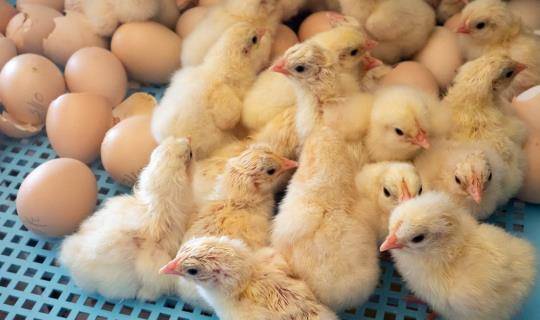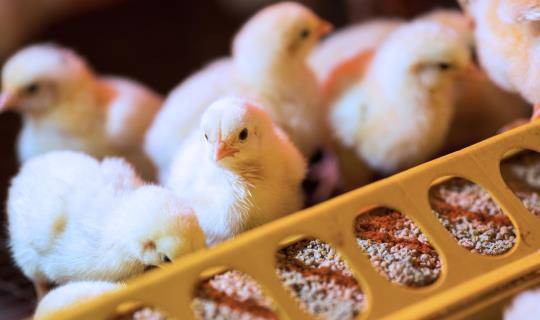Indianmeal moth management in animal production facilities
By MWI Technical Services

IMM adults are three-quarters inch long, copper-colored, with an off-white band across the middle of their wings. This is usually the first indication of a potential problem. These small moths are seen fluttering around feed. Adult female IMMs lay their eggs on feed or in the vicinity of food sources (e.g., stored grains, animal feed, cereals, dried fruit, dog food). The eggs hatch into larvae within two weeks and larvae begin to feed as they molt through 5–7 larval instars, depending on the food source and temperature (Fasulo and Knox, 2015). As the last larval instar prepares to pupate, they begin producing a silky webbing used to make their cocoons that causes feed and other debris to clump together. The cocoons are spun on top or within the feed but usually are placed against a hard surface, preferably in a corner. The pupal stage lasts for 1–3 weeks before adults emerge, mate, and lay more eggs. The entire life cycle typically takes 6–8 weeks during warmer months (Patrick, 2010). A single female can lay up to 400 eggs and lives for 5–25 days (Rutschky, 1990).
IMM management starts at the feed mill. At this site, insect-infested storage areas, conveyer belts, and feed delivery trucks need thoroughly cleaned by sweeping out or power spraying the waste grain, cobwebs, and other debris from the walls, floors, ceilings, rafters, and door frames. Even if the moths are not originating from the feed mill, this is where we have an opportunity to treat the feed with an insecticide, so that any stored product pests (including litter beetles) that consume the feed will get a dose of insecticide.
Diacon®-D IGR is an insect growth regulator (IGR) in a dust formulation that can be added at 0.33 pounds per ton to every batch of feed delivered to infested farms until the IMM population is adequately managed. This product contains the IGR, S-methoprene, and is approved for use on grain intended for animal consumption without any withdrawal requirements. This juvenile hormone analog prevents insects from molting into the next larval instar or into the pupal stage by mimicking the hormone that tells them it is not time to molt. Insects unable to reach the adult stage will not be able to reproduce. S-methoprene slows the development time of IMM larvae by about 26 hours and increases mortality by up to 81.6 ± 2.1% at temperatures above 68°F (Mohandass et al, 2006). Hydroprene, a juvenile hormone analog like S-methoprene, was shown to completely suppress adult emergence of almond moth, Cadra cautella (Mohandass et al, 2006) and caused sterility in adults (Bell and Edwards, 1999).
Unfortunately, there are very few insecticide products that are labeled for use on or over feed products. Evergreen® Pyrethrum Concentrate is an OMRI-certified organic product that is approved for application on and over feed. This product contains natural pyrethrins, a chemical extracted from chrysanthemum plants. Apply Evergreen Pyrethrum Concentrate to newly cleaned areas at 6 oz/gal of water as a coarse spray using a STIHL SR-450 backpack mist blower or other suitable spray equipment. Set the mist blower orange dial to 2.5 and the machine to an idle or slightly feather the throttle to deliver a coarse spray. One gallon of solution will cover 750 ft2.
On the farm, mechanically remove any webbing from clogged feed lines and feed storage bins. This can be easier said than done and will require some problem solving to address the needs on your farm. Mechanical removal of webbing can be done using power washing equipment, augers attached to drills, brooms, and a variety of other techniques. The webbing will not go away on its own even after the moths are killed and, therefore, it is critical to remove the webs mechanically to prevent the reoccurrence of clogged feedlines even in the absence of new pests. Apply Evergreen Pyrethrum Concentrate to newly cleaned feed lines and feed storage bins at 6 oz/gal of water as a coarse spray as described above.
Once IMM populations are reduced below an economic injury level—the level at which the damage caused by the pest justifies some type of control measure—monitoring for reinfestation becomes important. You can monitor for IMM using sticky straps such as EZ Trap® Fly Trap or Lure-Fly™ Fly Catchers placed near feed. The sticky traps are not going to attract the moths but are simply a passive way of capturing moths flying by. When moths are caught on sticky traps, it may be time to add Diacon-D IGR back into the feed ration or reapply Evergreen Pyrethrum Concentrate. Contact your MWI Animal Health Territory Manager for additional suggestions for your situation.






